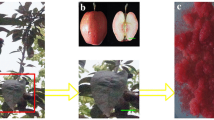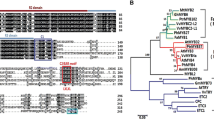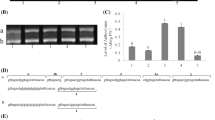Abstract
The WRKY transcription factors play key roles in plant growth and abiotic stress responses; however, the molecular mechanisms behind their involvement in anthocyanin biosynthesis are still unclear. In our study, we identified a Leu zipper motif and a WRKY domain in MdWRKY40 protein. Phylogenetic tree analysis showed that MdWRKY40, AtWRKY18 and AtWRKY40 were on the same evolutionary branch and were Group IIa WRKY proteins. Yeast two-hybrid and bimolecular fluorescence complementation assays showed that MdWRKY40 could interact with itself to form homodimers. Overexpressing MdMYB111 in red-fleshed callus inhibited the expression of MdANS and decreased the anthocyanin content. EMSA assay showed that MdMYB111 and MdWRKY40 could bind the MRE and the W box, respectively, in the MdANS promoter. Overexpressing MdWRKY40 in red-fleshed callus did not affect the expression of MdANS or the anthocyanin content. However, overexpressing MdWRKY40 in callus overexpressing MdMYB111 weakened the inhibitory effect of MdMYB111 on anthocyanin biosynthesis. Knocking out the Leu zipper motif of MdWRKY40 (LLSMdWRKY40) prevented its self-interaction, and knocking out C-x5-C sequence of MdWRKY40 (LCSMdWRKY40) prevented it from binding to W box. It did not weaken the inhibitory effect of MdMYB111 on anthocyanin biosynthesis when overexpressing LCSMdWRKY40 or LLSMdWRKY40 in callus overexpressing MdMYB111. Thus, MdMYB111 and MdWRKY40 may play important roles in the anthocyanin biosynthetic pathway.
Key message
MdWRKY40 interacts with itself to form homodimers by the Leu zipper motif at the N-terminal, and it binds two W boxes distantly separated in the MdANS promoter in the presence of C-x5-C sequence. MdMYB111 binds the MRE in the looped region induced by MdWRKY40. In addition, it weakens the inhibitory effect of MdMYB111 on expression of MdANS and anthocyanin biosynthesis when overexpressing MdWRKY40 in callus overexpressing MdMYB111.






Similar content being viewed by others
Abbreviations
- ANS:
-
Anthocyanin synthase
- UFGT:
-
UDP-glucose:flavonoid 3-glucosyltransferase
- AD:
-
Activation domain
- BD:
-
Binding domain
- EMSA:
-
Electrophoretic mobility shift assays
- Y2H:
-
Yeast two-hybrid
- –T(–Trp):
-
No tryptophan
- –L(–Leu):
-
No leucine
- –H(–His):
-
No histidine
- –A(–Ade):
-
No adenine
- Bifc:
-
Bimolecular fluorescence complementation
- MRE:
-
MYB-recognition element
- YFP:
-
Yellow fluorescent protein
References
Aharoni A, De Vos C, Wein M, Sun Z, Greco R, Kroon A, Mol JN, O’connell AP (2001) The strawberry FaMYB1 transcription factor suppresses anthocyanin and flavonol accumulation in transgenic tobacco. Plant J 28(3):319–332
Albert NW, Lewis DH, Zhang H, Schwinn KE, Jameson PE, Davies KM (2011) Members of an R2R3-MYB transcription factor family in Petunia are developmentally and environmentally regulated to control complex floral and vegetative pigmentation patterning. Plant J 65:771–784
Albert NW, Davies KM, Lewis DH, Zhang H, Montefiori M, Brendolis C, Boase MR, Ngo H, Jameson PE, Schwinn KE (2014) A conserved network of transcriptional activators and repressors regulates anthocyanin pigmentation in Eudicots. Plant Cell 26:962–980
An XH, Tian Y, Chen KQ, Liu XJ, Liu DD, Xie XB, Cheng CG, Cong PH, Hao YJ (2015) MdMYB9 and MdMYB11 are involved in the regulation of the JA-induced biosynthesis of anthocyanin and proanthocyanidin in apples. Plant Cell Physiol 56(4):650–662
Azuma A, Kobayashi S, Mitani N, Shiraishi M, Yamada M, Ueno T, Kono A, Yakushiji H, Koshita Y (2008) Genomic and genetic analysis of Myb-related genes that regulate anthocyanin biosynthesis in grape berry skin. Theor Appl Genet 117:1009–1019
Ballester AR, Molthoff J, de Vos R, te Lintel HB, Orzaez D, Fernandezmoreno JP, Tripodi P, Grandillo S, Martin C, Heldens J, Ykema M, Granell A, Bovy A (2010) Biochemical molecular analysis of pink tomatoes, deregulated expression of the gene encoding transcription factor SlMYB12 leads to pink tomato fruit color. Plant Physiol 152:71–84
Ban Y, Honda C, Hatsuyama Y, Igarashi M, Bessho H, Moriguchi T (2007) Isolation and functional analysis of a MYB transcription factor gene that is a key regulator for the development of red coloration in apple skin. Plant Cell Physiol 48:958–970
Baudry A, Heim MA, Dubreucq B, Caboche M, Weisshaar B, Lepiniec L (2004) TT2, TT8 and TTG1 synergistically specify the expression of BANYULS and proanthocyanidin biosynthesis in Arabidopsis thaliana. Plant J 39(3):366–380
Besseau S, Li J, Palva ET (2012) WRKY54 and WRKY70 cooperate as negative regulators of leaf senescence in Arabidopsis thaliana. J Exp Bot 63:2667–2679
Boyer J, Liu RH (2004) Apple phytochemicals and their health benefits. Nutr J. https://doi.org/10.1186/1475-2891-3-5
Cavallini E, Matus JT, Finezzo L, Zenoni S, Loyola R, Guzzo F, Schlechter R, Ageorges A, Arce-Johnson P, Tornielli GB (2015) The phenylpropanoid pathway is controlled at different branches by a set of R2R3-MYB C2 repressors in grapevine. Plant Physiol 167:1448–1470
Chen YF, Li LQ, Xu Q, Kong YH, Wang H, Wu WH (2009) The WRKY6 transcription factor modulates PHOSPHATE1 expression in response to low Pi stress in Arabidopsis. Plant Cell 21:3554–3566
Chi YJ, Yang Y, Zhou Y, Zhou J, Fan BF, Yu JQ, Chen ZX (2013) Protein-protein interactions in the regulation of WRKY transcription factors. Mol Plant 6:287–300
Cook NC, Samman S (1996) Flavonoids-chemistry, metabolism, cardiop rotective effects, and dietary sources. J Nutr Biochem 7:66–76
Cormack RS, Eulgem T, Rushton PJ, Kochner P, Hahlbrock K, Somssich IE (2002) Leucine zipper-containing WRKY proteins widen the spectrum of immediate early elicitor-induced WRKY transcription factors in parsley. Biochim Biophys Acta 1576:92–100
Duan SW, Wang JJ, Gao CH, Jin CY, Li D, Peng DS, Du GM, Li YQ, Chen MX (2018) Functional characterization of a heterologously expressed Brassica napus WRKY41-1 transcription factor in regulating anthocyanin biosynthesis in Arabidopsis thaliana. Plant Sci 268:47–53
Eulgem T, Rushton PJ, Robatzek S, Somssich IE (2000) The WRKY superfamily of plant transcription factors. Trends Plant Sci 5:199–206
Feller A, Machemer K, Braun EL, Grotewold E (2011) Evolutionary and comparative analysis of MYB and bHLH plant transcription factors. Plant J 66(1):94–116
Feng SQ, Wang YL, Song Y, Xu YT, Chen XS (2010) Anthocyanin biosynthesis in pears is regulated by a R2R3-MYB transcription factor PyMYB10. Planta 232:245–255
Hartmann U, Sagasser M, Mehrtens F, Stracke R, Weisshaar B (2005) Differential combinatorial interactions of cis-acting elements recognized by R2R3-MYB, BZIP, and BHLH factors control light-responsive and tissue-specific activation of phenylpropanoid biosynthesis genes. Plant Mol Biol 57(2):155–171
Hichri I, Barrieu F, Bogs J, Kappel C, Delrot S, Lauvergeat V (2011) Recent advances in the transcriptional regulation of the flavonoid biosynthetic pathway. J Exp Bot 62(8):2465–2483
Ji XH, Wang YT, Zhang R, Wu SJ, An MM, Li M, Wang CZ, Chen XL, Zhang YM, Chen XS (2015) Effect of auxin, cytokinin and nitrogen on anthocyanin biosynthesis in callus cultures of redfleshed apple (Malus sieversii f. niedzwetzkyana). Plant Cell Tissue Organ Cult 120:325–337
Jiang Y, Deyholos M (2009) Functional characterization of Arabidopsis NaCl-inducible WRKY25 and WRKY33 transcription factors in abiotic stresses. Plant Mol Biol 69:91–105
Jiang YJ, Liang G, Yu DQ (2012) Activated expression of WRKY57 confers drought tolerance in Arabidopsis. Mol Plant 5:1375–1388
Kenneth JL, Thomas DS (2001) Analysis of relative gene expression data using real-time quantitative PCR and the 2−ΔΔCT method. Methods 25:402–408
Kim SY, Lee JR, Kim SR (2006) Characterization of an apple anthocyanidin synthase gene in transgenic tobacco. Plants J Plant Biol 49(4):326–330
Koes R, Verweij W, Quattrocchio F (2005) Flavonoids, a colorful model for the regulation and evolution of biochemical pathways. Trends Plant Sci 10:236–242
Kondo S, Hiraoka K, Kobayashi S, Honda C, Terahara N (2002) Changes in the expression of anthocyanin biosynthetic genes during apple development. J Am Soc Hortic Sci 127:971–976
Landschulz WH, Johnson PF, McKnight SL (1988) The leucine zipper: a hypothetical structure common to a new class of DNA binding proteins. Science 240:1759–1764
Li HH, Liu X, An JP, Hao YJ, Wang XF, You CX (2017) Cloning and elucidation of the functional role of apple MdLBD13 in anthocyanin biosynthesis and nitrate assimilation. Plant Cell Tissue Organ Cult 130:47–59
Rushton PJ, Somssich IE, Ringler P, Shen QJ (2010) WRKY transcription factors. Trends Plant Sci 15:247–258
Sun CD, Huang HZ, Xu CJ, Li X, Chen KS (2013) Biological activities of extracts from Chinese bayberry (Myrica rubra Sieb. et Zucc.): a review. Plant Foods Hum Nutr 68(2):97–106
Sun JJ, Wang YC, Chen XS, Gong XJ, Wang N, Ma L, Qiu YF, Wang YL, Feng SQ (2017) Effects of methyl jasmonate and abscisic acid on anthocyanin biosynthesis in callus cultures of red-fleshed apple. Plant Cell Tissue Organ Cult 130:227–237
Takos AM, Jaffé FW, Jacob SR, Bogs J, Robinson SP, Walker AR (2006) Light-induced expression of a MYB gene regulates anthocyanin biosynthesis in red apples. Plant Physiol 142(3):1216–1232
Wang Z, Yang P, Fan B, Chen Z (1998) An oligo selection procedure for identification of sequence-specific DNA-binding activities associated with the plant defence response. Plant J 16:515–522
Wang LK, Bolitho K, Grafton K, Kortstee A, Karunairetnam S, McGhie TK, Espley RV, Hellens RP, Allan AC (2010) An R2R3 MYB transcription factor associated with regulation of the anthocyanin biosynthetic pathway in Rosaceae. BMC Plant Biol 10:50
Wang N, Zhang ZY, Jiang SH, Xu HF, Wang YC, Feng SQ, Chen XS (2016) Synergistic effects of light and temperature on anthocyanin biosynthesis in callus cultures of red-fleshed apple. Plant Cell Tissue Organ Cult 127:217–227
Wu X, Shiroto Y, Kishitani S, Ito Y, Toriyama K (2009) Enhanced heat and drought tolerance in transgenic rice seedlings overexpressing OsWRKY11 under the control of HSP101 promoter. Plant Cell Rep 28:21–30
Xie XB, Zhao J, Hao YJ, Fang CB, Wang Y (2017) The ectopic expression of apple MYB1 and bHLH3 differentially activates anthocyanin biosynthesis in tobacco. Plant Cell Tissue Organ Cult 131:183–194
Xu X, Chen C, Fan B, Chen Z (2006) Physical and functional interactions between pathogen-induced Arabidopsis WRKY18, WRKY40, and WRKY60 transcription factors. Plant Cell 18:1310–1326
Xu F, Ning Y, Zhang W, Liao Y, Li L, Cheng H, Cheng S (2014) An R2R3-MYB transcription factor as a negative regulator of the flavonoid biosynthesis pathway in Ginkgo biloba. Funct Integr Genomics 14(1):177–189
Xu HF, Wang N, Liu JX, Qu CZ, Wang YC, Jiang SH, Lu NL, Wang DY, Zhang ZY, Chen XS (2017) The molecular mechanism underlying anthocyanin metabolism in apple using the MdMYB16 and MdbHLH33 genes. Plant Mol Biol 94:149–165
Zhang WS, Li X, Zheng JT, Wang GY, Sun CD, Ferguson IB, Chen KS (2008) Bioactive components and antioxidant capacity of Chinese bayberry (Myrica rubra Sieb. and Zucc.) fruit in relation to fruit maturity and postharvest storage. Eur Food Res Technol 227(4):1091–1097
Acknowledgements
We thank Emma Tacken, PhD, and Lesley Benyon, PhD, from Liwen Bianji, Edanz Group China (www.liwenbianji.cn/ac), for editing the English text of a draft of this manuscript.
Funding
This work was supported by the National Natural Science Foundation of China (31572091 and 31730080) and the National Key Research and Development Project (SQ2016YFSF030011).
Author information
Authors and Affiliations
Contributions
Tianliang Zhang and Haifeng Xu have contributed equally to this work. Xuesen Chen and Tianliang Zhang: conceived and designed the experiments. Tianliang Zhang and Haifeng Xu: performed the experiments. Tianliang Zhang: analyzed the data. Haifeng Xu, Guanxian Yang, Jing Zhang, Nan Wang, Yicheng Wang, Shenghui Jiang, Hongcheng Fang, Zongying Zhang: contributed reagents/materials/analysis tools. Tianliang Zhang and Xuesen Chen: wrote the paper.
Corresponding author
Ethics declarations
Conflict of interest
The authors declare no competing financial interests.
Additional information
Communicated by Henryk Flachowsky.
Publisher's Note
Springer Nature remains neutral with regard to jurisdictional claims in published maps and institutional affiliations.
Electronic supplementary material
Below is the link to the electronic supplementary material.
Rights and permissions
About this article
Cite this article
Zhang, T., Xu, H., Yang, G. et al. Molecular mechanism of MYB111 and WRKY40 involved in anthocyanin biosynthesis in red-fleshed apple callus. Plant Cell Tiss Organ Cult 139, 467–478 (2019). https://doi.org/10.1007/s11240-019-01637-z
Received:
Accepted:
Published:
Issue Date:
DOI: https://doi.org/10.1007/s11240-019-01637-z




